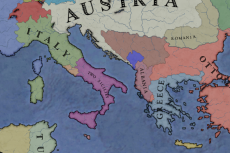
Email: ZYVC057@live.rhul.ac.uk
Total Article : 213
About Me:I'm a graduate student studying International Criminal Law and first started writing for King's News almost 4 years ago! My hobbies include reading, travelling and charity work. I cover many categories but my favourite articles to write are about mysteries of the ancient world, interesting places to visit, the Italian language and animals!

If you’ve travelled around Italy you will have noticed the undeniable difference between the north and south; it isn’t simply a matter of different weather or shops, rather it is the result of centuries of division. Since the formation of Italy in 1861 the country has been divided by economy, dialects and customs – as described best in Luca Miniero’s comical films ‘Benvenuti al Sud’ and ‘Benvenuti al nord’, despite this apparent divide I could never consider Italy to be two complete distinct areas that should be separated, but rather two equally beautiful in their own way parts that make up a nation. Some, like the Italian extreme right wing part the northern league do wish to disassociate the north from the south to the extent of dividing the nation into two separate geographical entities, calling the north Padania.
Within Italy, debates about the south began to surface in multiple areas, ranging from public policy to literature. Although the ‘questione meridionale’ or ‘southern question’ began to be heavily discussed following the unification of Italy when the poverty of the south was extremely apparent compared to the industrialised north, the roots of the southern question date way back to the 1700s, if not before. After gaining independence from Spain in 1734, the Kingdom of the Two Sicilies sought to first reform then abolish the old tradition of feudalism, a system of obligation which uses land as a means to guarantee power and protection. This plan was however subject to setbacks: first, the French Revolution which circulated the idea of reforms being dangerous; next, the invasion of Napoleon’s army; finally, the local uprisings of 1848. There was a period of tranquillity between the restoration of 1815 and the months prior to the uprising in 1848 which sought the rise of the middle class which would meet secretly in Naples and other provinces. These reformers were nonetheless disillusioned by the times of panic they lived in and many reformers ended up in prison or exile; many of the newly exiles in the north would rearm and attempt to unify the nation in the years to come. The southern question was really born in the years following Italian unification, from 1974 to 1884, when the idea of a ‘moral geography’ began to circulate – that is the idea of summarising all of Italy’s ills and identifying them solely with one region, the south. The south did indeed face many issues, when Italy was created the south had to adapt to the flowing markets, language and customs of its new county. Many southerners were illiterate and only spoke the dialect of their region, they weren’t used to the new penal and fiscal systems they were forced to embrace. The south was widely inexperienced compared to the high technological advances of the north and found the rural region of the south simply could not keep up. Brigandage became intensely influential in southern Italy and organised crime in the form of the mafia became intricately intertwined with the new nation. Whilst the poor became poorer, some did benefit from the new regime and were able to obtain new administrative tasks. This all calls upon an image of the South as being completely different from the rest of the peninsular and depicts the southerners as ‘passionate, undisciplined, rebellious, intensely competitive, and incapable of generating group solidarity or engaging in collective action’ (Jane Schneider1998). Still to-date, the image of two distinct areas is undeniable, the undeveloped regions are the product an integral part of the history and political struggle of the south of Italy. The case however is not wholly lost: as former editor of the economist Bill Emmott famously said, all the beautiful Italic peninsular has to do is wake up and react.
Image: http://image.noelshack.com/fichiers/2015/15/1428327453-italy-and-greece.png

0 Comment:
Be the first one to comment on this article.